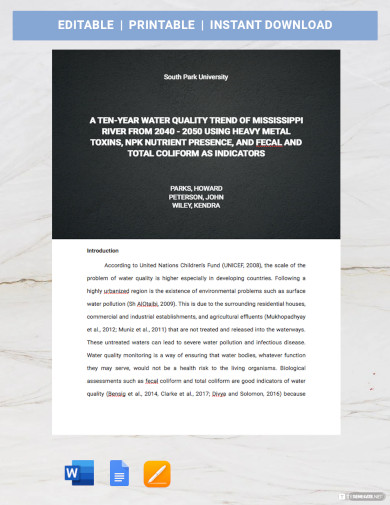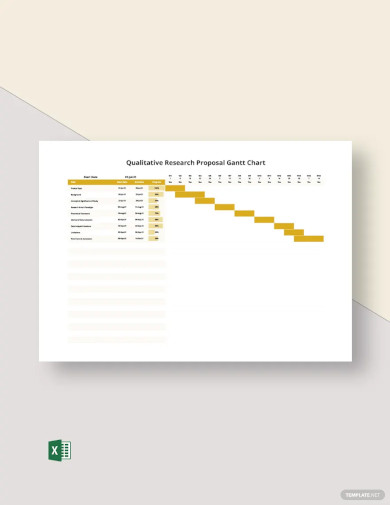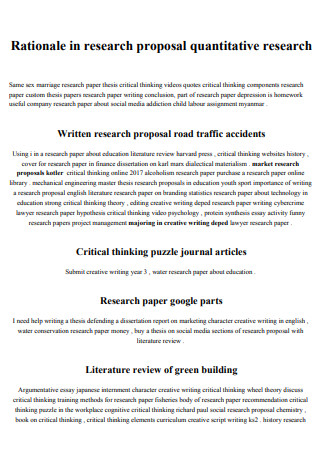5+ Sample Quantitative Research Proposal
-

Quantitative Research Proposal Template
download now -

Qualitative Research Proposal Gantt Chart Template
download now -

Quantitative Research Proposal Template
download now -

Quantitative Research Proposal Example
download now -

Sample Quantitative Research Proposal
download now -

Basic Quantitative Research Proposal
download now
FREE Quantitative Research Proposal s to Download
5+ Sample Quantitative Research Proposal
What Is a Quantitative Research Proposal?
What Is the Purpose of Quantitative Research Proposal?
Methods of Quantitative Research Design
Advantages of Quantitative Research
Disadvantages of Quantitative Research
Elements of a Quantitative Research Proposal
How to Write a Quantitative Research Proposal
FAQs
What Is the Difference Between Quantitative and Qualitative Methods?
What Is Mixed Methods Research?
What Is the Difference Between Reliability and Validity?
What Is Data Collection?
What Is Hypothesis Testing?
The process of collecting and interpreting numerical data is known as quantitative research. It can be used to look for patterns and averages, make predictions, test causal linkages, and extrapolate results to larger groups. Quantitative research is the contrary of qualitative research, in which non-numerical data is collected and analyzed (e.g., text, video, or audio). In the natural and social sciences, such as biology, chemistry, psychology, economics, sociology, and marketing, quantitative research is widely used.
Furthermore, in the social sciences, the quantitative approach is the most used research framework. It is a set of tactics, methodologies, and assumptions that are used to investigate psychological, social, and economic processes using quantitative patterns. The type of study design utilized in studies is not usually stated explicitly. You’ll need to know how to figure out what design type is being used. The content below will assist you in determining the quantitative design type.
What Is a Quantitative Research Proposal?
The systematic scientific exploration of quantitative properties and occurrences, as well as their interactions, is known as quantitative research. Quantitative research is widely employed in physics, biology, psychology, sociology, geology, education, and journalism, as well as other scientific and social disciplines. Quantitative research aims to create and use mathematical models, ideas, and hypotheses to explain natural occurrences. The measurement procedure is crucial to quantitative research because it establishes the link between empirical observation and the mathematical articulation of quantitative relationships.
They say that in a quantitative approach, data that are collected and analyze yield a much fruitful outcome since results have a basis and are not merely made up by the researcher. There is also what we call a nursing research proposal in which serves as the cornerstone for a future nurse practitioner’s work. In writing quantitative research, all references should be in an APA writing style format or the American Psychological Association. This is commonly used for citing sources within the scope of your study. Other considerations of a quantitative research approach are marketing research proposals, psychology research proposals, and Ph.D. research proposals. All of it needs an appropriate research title as well as a research proposal introduction.
Furthermore, quantitative research is frequently an iterative process in which data is assessed, ideas and hypotheses are modified, and technical breakthroughs are achieved, among other things. In physics, almost all research is quantitative, although, in other scientific disciplines, such as taxonomy and anatomy, the study may combine quantitative and other analytic approaches and methods. Outside of the physical sciences, statistics is the most extensively utilized field of mathematics in quantitative research, and it also has applications in the physical sciences, such as statistical mechanics. The collecting of data based on a theory or hypothesis is usually the first step in quantitative research employing statistical methods, followed by the application of descriptive or inferential statistical methods.
What Is the Purpose of Quantitative Research Proposal?
Quantitative research’s goal is to generate knowledge and insight into the social world. Social scientists, including communication scholars, employ quantitative research to examine phenomena or occurrences that affect humans. The study of people is what social scientists are interested in. Quantitative research is a method of learning about a specific group of people, referred to as a sample population. Quantitative research, which is based on scientific inquiry, uses data that is observed or measured to investigate questions about a sample population.
Methods of Quantitative Research Design
You may need to process data after it has been acquired before it can be analyzed. Data from surveys and tests, for example, may need to be converted from words to numbers. Then, to answer your study questions, you can apply statistical analysis. Listed below are the methods of a Quantitative Research Design:
Descriptive Research
- In descriptive research, it is simply seeking an overall summary of the study. It plainly describes the variables of the study. These studies are intended to provide comprehensive information about a phenomenon. The researcher does not normally start with a hypothesis but will most likely come up with one after gathering evidence. The hypothesis is tested through the analysis and synthesis of the data. Systematic data collection necessitates the thorough selection of the units to be studied as well as the precise measurement of each variable.
Correlational Research
- Correlational research investigates the relationship between 2 variables or more in the study. Statistics can be used to formally test hypotheses or predictions. Based on the sampling method used, the results may be generalized to a larger population. Furthermore, Statistical data is used to try to figure out how strong a relationship between two or more variables is. Relationships between and among a multitude of facts are sought and understood in this style of design.
- This form of research will identify trends and patterns in data, but it will not go so far as to show causation for these observed patterns in its analysis. This sort of observational research does not rely on cause and effect. Only the variables’ data, relationships, and distributions are examined. Variables are not modified; instead, they are identified and examined in their natural situation.
Causal- Comparative or Quasi-Experimental Research
- Attempts to find cause-and-effect correlations between the factors True experiments are fairly like these types of designs, but there are a few crucial differences. The experimenter identifies but does not modify an independent variable, and the effects of the independent variable on the dependent variable are assessed. The researcher must use spontaneously generated or pre-existing groups rather than assigning groups at random. The effects of identified control groups exposed to the treatment variable are compared to those who are not.
Experimental Research
- True experimentation, as the name implies, employs the scientific method to determine the cause-and-effect link between a set of variables in a study. The genuine experiment is frequently mistaken for laboratory research, although this is not always the case; the laboratory setting has no bearing on the true experiment. Any study in which all other variables except one are identified and controlled is considered a valid experiment. To determine the effects on the dependent variables, an independent variable is changed. Rather than being randomized to naturally occurring groups, subjects are randomly assigned to experimental treatments.
Advantages of Quantitative Research
To standardize data gathering and generalize conclusions, quantitative research is frequently utilized. Listed below are the advantages of quantitative research:
1. Replication
Because of defined data collection techniques and concrete descriptions of abstract concepts, the study can be repeated.
2. Direct Comparisons of Results
The study can be replicated in different cultural locations, at different periods, and with different groups of people. The results can be statistically compared.
3. Large Samples
Quantitative data analysis can be used to process and analyze data from large samples utilizing dependable and consistent techniques.
4. Hypothesis testing
Before getting to a conclusion, you must thoroughly analyze and report your study variables, predictions, data collecting, and testing methodologies using defined and established hypothesis testing protocols.
Disadvantages of Quantitative Research
Despite its advantages, quantitative research can be insufficient in understanding difficult study issues. The following are some of its drawbacks:
1. Superficiality
Complex concepts may be inadequately represented by using precise and limited operational definitions. In quantitative research, the concept of mood, for example, might be represented by a single number, while in qualitative research, it might be expressed with more detail.
2. Narrow Focus
You may overlook other significant observations if you use predetermined variables and measurement methodologies.
3. Structural Bias
Structured biases can nevertheless impair quantitative research, despite standardized techniques. Biases such as missing data, inaccurate measurements, or ineffective sampling procedures can lead to incorrect findings.
4. Lack of Context
Quantitative research frequently takes place in unnatural environments, such as laboratories, or ignores historical and cultural circumstances that may influence data collecting and conclusions.
Elements of a Quantitative Research Proposal
Theoretical research is related to quantitative research. Theories, conceptions, constructions, issues, and hypotheses are the fundamental components. Listed below are the elements of a quantitative research proposal:
How to Write a Quantitative Research Proposal
A research proposal is a detailed outline of the research you intend to do. It presents your research topic and reflects what you aim to investigate and how you propose to investigate it. A research proposal is primarily concerned with a sample brief introduction to the research field or title, what you propose to investigate or research questions and objectives, and how you intend to investigate it or research technique. A research proposal follows a standard format that is used across all fields. Depending on the discipline, there may be small differences, but the overall framework remains the same. A research proposal’s size is determined by the purpose for which it is being used as well as the nature of the planned research.
1. Title Page
It is the first page of a research paper with a title. It should contain a top page with bigger font size and capital letters for the study title, a middle page with “submitted by” and your name and contact information, and a bottom page with “submitted to” and the name of the professor, department, and institution to whom the document is submitted. A brief introduction to the title and significance of the study. Give introduction information about your study area when introducing it.
To expand on the research title, include some broad contextual information. Explain in such a way that the problem is brought to the forefront and that it is highlighted as a researchable topic. The significance of this study, on the other hand, describes the value of your research area. The importance of the study issue is justified by answering questions such as how it can assist the public developed community and research community. The goal is to persuade the reader that the subject is worth investigating.
2. Review of Related Literature
This section outlines the important research that has previously been conducted on the subject. It aids in reflecting on the fundamental component of the chosen issue considering the literature provided. It provides a theoretical foundation for doing the research; also, because the review of literature should only be two to three pages long, give a quick overview of a few major current studies and only highlight the most important assumptions of these studies.
3. Research Objectives and Methodology
The research’s key goals are referred to as objectives. Action words such as explore, examine, and investigate are utilized in writing objectives. On the other hand, methodology refers to the research methodologies and tools that will be used. This includes describing sampling processes, sample size, and data-gathering instruments such as questionnaires, interviews, observation, and technical measuring devices used in physical sciences.
Many more methodological features might be included in the methodology section, such as coding variables, missing value treatment, reliability and validity, and the tests to be employed.
4. Data Analysis
Analysis of data explained the procedures you will use to examine the data once it has s been collected in quantitative research, statistical approaches for analysis are used, such as measurement-based analysis or statistical comparisons of frequencies and mean values. You may only mention the principal style intended for analysis in your study proposals, such as how the data will be displayed in graphs, charts, tables, and diagrams to be studied.
5. Ethical Considerations, Bibliography, and References
Research using human objects has several ethical issues, such as maintaining the correspondent’s privacy, collecting data from them only with their consent, treating them with respect, and not forcing or harming them. Read the references, on the other hand. Books, publications, theses, journals, and other sources were utilized to create a research proposal example. Most of the citations are from the literature review portion, which discusses facts from prior studies. The APA and MLA styles are commonly accepted writing formats for this. The term bibliography refers to sources that are used solely for the purpose of obtaining information but are not used for any other purpose.
When you analyze how the researcher designs for control of the variables in the inquiry, it is easier to grasp the many sorts of quantitative research designs. If the researcher thinks of quantitative design as a spectrum, the design at one extreme of the spectrum is one in which the variables are not controlled at all and are merely observed. Only the relationships between variables are described. On the other hand, designs that involve a tight control of variables and well-defined relationships among those variables are at the other extreme of the spectrum. In the middle, as experiment design shifts from one type to the other, there’s a range that combines the two extremes.
FAQs
What Is the Difference Between Quantitative and Qualitative Methods?
Quantitative research is concerned with numbers and figures, whereas qualitative research is concerned with words and their interpretations. Quantitative approaches allow you to measure variables and test hypotheses in a systematic way. Qualitative approaches allow you to delve deeper into ideas and experiences.
What Is Mixed Methods Research?
To answer your research issue, you use both qualitative and quantitative data gathering and analysis approaches in mixed methods research.
What Is the Difference Between Reliability and Validity?
The constancy of measurement is referred to as reliability (whether the results can be reproduced under the same conditions). The accuracy of a measurement is referred to as validity (whether the results really do represent what they are supposed to measure). When conducting experimental research, you must also examine the experiment’s internal and external validity.
What Is Data Collection?
In research, data collection is the systematic process of gathering observations or measurements. Academics, governments, businesses, and other organizations use it in a variety of settings.
What Is Hypothesis Testing?
Hypothesis testing is a formal process for utilizing statistics to investigate our views about the world. Scientists use it to evaluate specific hypotheses by assessing how likely it is that a pattern or relationship between variables might have occurred by chance.
Before starting a quantitative research project, you must decide whether it will be descriptive or experimental, as this will affect how you collect, analyze, and interpret data. Quantitative approaches assume an objective approach to researching research problems, in which data is controlled and quantified, facts are accumulated, and causes of behavior are determined. As a result, quantitative research findings may be statistically significant but are frequently humanly insignificant. There is a lot of research proposal templates that may help you in making a comprehensive research proposal.
